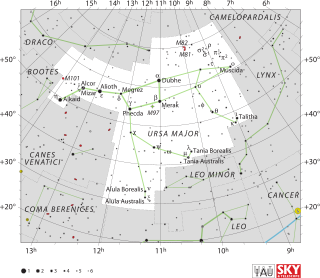Psi Ursae Majoris
| Observation data Epoch J2000.0 Equinox J2000.0 (ICRS) | |
|---|---|
| Constellation | Ursa Major |
| Right ascension | 11h 09m 39.8083s[1] |
| Declination | +44° 29′ 54.5559″[1] |
| Apparent magnitude (V) | +3.01[2] |
| Characteristics | |
| Evolutionary stage | Giant star |
| Spectral type | K1 III[3] |
| U−B color index | +1.12[2] |
| B−V color index | +1.14[2] |
| Astrometry | |
| Radial velocity (Rv) | –3.39[4] km/s |
| Proper motion (μ) | RA: –62.02 mas/yr[1] Dec.: –27.78 mas/yr[1] |
| Parallax (π) | 23.2272 ± 0.2513 mas[1] |
| Distance | 140 ± 2 ly (43.1 ± 0.5 pc)[1] |
| Absolute magnitude (MV) | −0.27[5] |
| Details[6] | |
| Mass | 2.31±0.13 M☉ |
| Radius | 19.12[6]–20.79[7] R☉ |
| Luminosity | 140±3 L☉ |
| Surface gravity (log g) | 2.12±0.05 cgs |
| Temperature | 4,543±6 K |
| Metallicity [Fe/H] | −0.11±0.03 dex |
| Rotational velocity (v sin i) | 5.5[8] km/s |
| Other designations | |
| Database references | |
| SIMBAD | data |
Psi Ursae Majoris (Psi UMa, ψ Ursae Majoris, ψ UMa) is a star in the northern circumpolar constellation of Ursa Major. It has an apparent visual magnitude of +3.01,[2] making it a third magnitude star and one of the brighter members of the constellation. Parallax measurements place it at a distance of 140 light-years (43 parsecs) from Earth.[1] This is sufficiently close that the magnitude of the star is only reduced by 0.05 due to extinction.[4] In Chinese astronomy, Psi Ursae Majoris is called Tien Tsan or Ta Tsun, "Extremely Honorable".[10] The name was possibly derived from the word 太尊, Pinyin: Tàizūn, meaning Royals, because this star stands alone as the only member of the Royals asterism within the Purple Forbidden enclosure (see Chinese constellation).
The spectrum of this star matches a stellar classification of K1 III,[3] with the luminosity class of 'III' indicating this is an evolved giant star that has exhausted the supply of hydrogen at its core. As a consequence, it has expanded to around 20 times the radius of the Sun.[7][6] It is radiating roughly 140 times the luminosity of the Sun from its enlarged outer envelope at an effective temperature of 4,543 K.[6] At this heat, the star glows with the orange hue of a K-type star.[11]
Psi Ursae Majoris is a member of the thin disk population of the Milky Way. It is following an orbit through the galaxy with a low eccentricity of 0.02 that will carry it between 26.5–27.8 kly (8.1–8.5 kpc) from the Galactic Center. The low inclination of its orbit means the star will only stray 130 ly (40 pc) from the galactic plane.[12]
References
[edit]- ^ a b c d e f Vallenari, A.; et al. (Gaia collaboration) (2023). "Gaia Data Release 3. Summary of the content and survey properties". Astronomy and Astrophysics. 674: A1. arXiv:2208.00211. Bibcode:2023A&A...674A...1G. doi:10.1051/0004-6361/202243940. S2CID 244398875. Gaia DR3 record for this source at VizieR.
- ^ a b c d Jennens, P. A.; Helfer, H. L. (September 1975), "A new photometric metal abundance and luminosity calibration for field G and K giants.", Monthly Notices of the Royal Astronomical Society, 172 (3): 667–679, Bibcode:1975MNRAS.172..667J, doi:10.1093/mnras/172.3.667
- ^ a b Frasca, A.; et al. (December 2009), "REM near-IR and optical photometric monitoring of pre-main sequence stars in Orion. Rotation periods and starspot parameters", Astronomy and Astrophysics, 508 (3): 1313–1330, arXiv:0911.0760, Bibcode:2009A&A...508.1313F, doi:10.1051/0004-6361/200913327, S2CID 118361131
- ^ a b Famaey, B.; et al. (January 2005), "Local kinematics of K and M giants from CORAVEL/Hipparcos/Tycho-2 data. Revisiting the concept of superclusters", Astronomy and Astrophysics, 430: 165–186, arXiv:astro-ph/0409579, Bibcode:2005A&A...430..165F, doi:10.1051/0004-6361:20041272, S2CID 17804304
- ^ Cardini, D. (January 2005), "Mg II chromospheric radiative loss rates in cool active and quiet stars", Astronomy and Astrophysics, 430: 303–311, arXiv:astro-ph/0409683, Bibcode:2005A&A...430..303C, doi:10.1051/0004-6361:20041440, S2CID 12136256.
- ^ a b c d Soubiran, C.; Creevey, O. L.; Lagarde, N.; Brouillet, N.; Jofré, P.; Casamiquela, L.; Heiter, U.; Aguilera-Gómez, C.; Vitali, S.; Worley, C.; de Brito Silva, D. (2024-02-01). "Gaia FGK benchmark stars: Fundamental Teff and log g of the third version". Astronomy and Astrophysics. 682: A145. arXiv:2310.11302. Bibcode:2024A&A...682A.145S. doi:10.1051/0004-6361/202347136. ISSN 0004-6361. Psi Ursae Majoris' database entry at VizieR.
- ^ a b Gray, David F.; Kaur, Taranpreet (2019-09-01). "A Recipe for Finding Stellar Radii, Temperatures, Surface Gravities, Metallicities, and Masses Using Spectral Lines". The Astrophysical Journal. 882 (2): 148. Bibcode:2019ApJ...882..148G. doi:10.3847/1538-4357/ab2fce. ISSN 0004-637X.
- ^ Massarotti, Alessandro; et al. (January 2008). "Rotational and Radial Velocities for a Sample of 761 HIPPARCOS Giants and the Role of Binarity". The Astronomical Journal. 135 (1): 209–231. Bibcode:2008AJ....135..209M. doi:10.1088/0004-6256/135/1/209. S2CID 121883397.
- ^ "psi UMa -- Star", SIMBAD, Centre de Données astronomiques de Strasbourg, retrieved 2012-01-16
- ^ Allen, Richard Hinckley (1963), Star Names — Their Lore and Meaning: Ursa Major (Dover ed.), University of Chicago
- ^ "The Colour of Stars", Australia Telescope, Outreach and Education, Commonwealth Scientific and Industrial Research Organisation, December 21, 2004, archived from the original on March 18, 2012, retrieved 2012-01-16
- ^ Soubiran, C.; et al. (2008), "Vertical distribution of Galactic disk stars. IV. AMR and AVR from clump giants", Astronomy and Astrophysics, 480 (1): 91–101, arXiv:0712.1370, Bibcode:2008A&A...480...91S, doi:10.1051/0004-6361:20078788, S2CID 16602121

